Liberty Seated Silver Dollar
1840 to 1865 No Motto
1866 to 1873 Motto
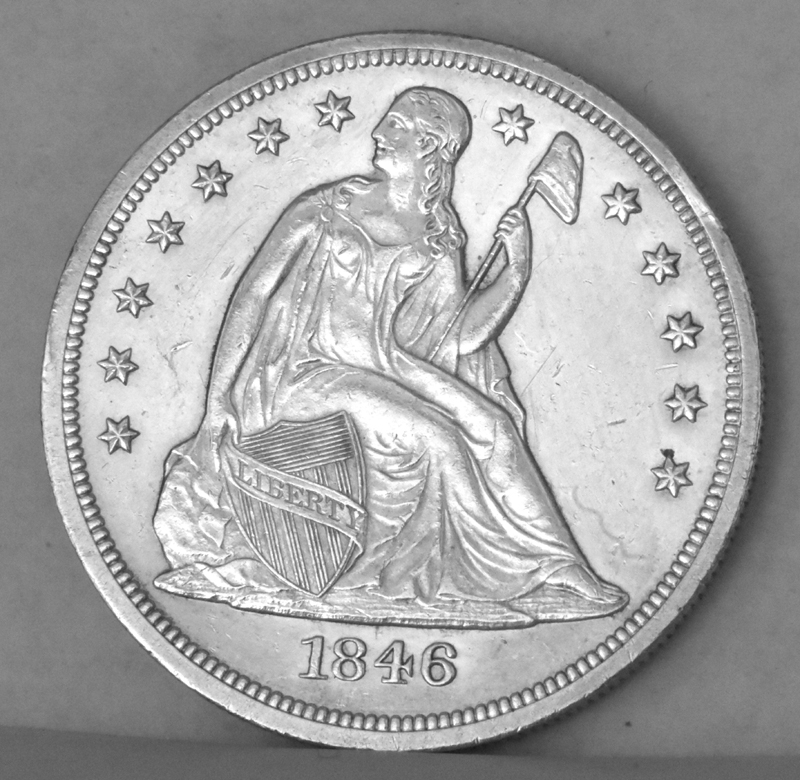 |
Both the Flowing Hair dollar and the Draped Bust dollar are rare enough that any example in more than extremely poor condition will cost $1000 or more and thus, these coins are not included in the albums that I have in my collection. Also, the first Liberty Seated dollars, which appeared during 1836 to 1839, are extremely rare and also very expensive. The first dollar to be minted in large quantities was the Liberty Seated of 1840, with the shield eagle on the reverse. Two variations are notable: the first having no motto and the second having IN GOD WE TRUST displayed on a banner above the eagle on the reverse. The composition of the coin and its size remained the same as in the early types. | 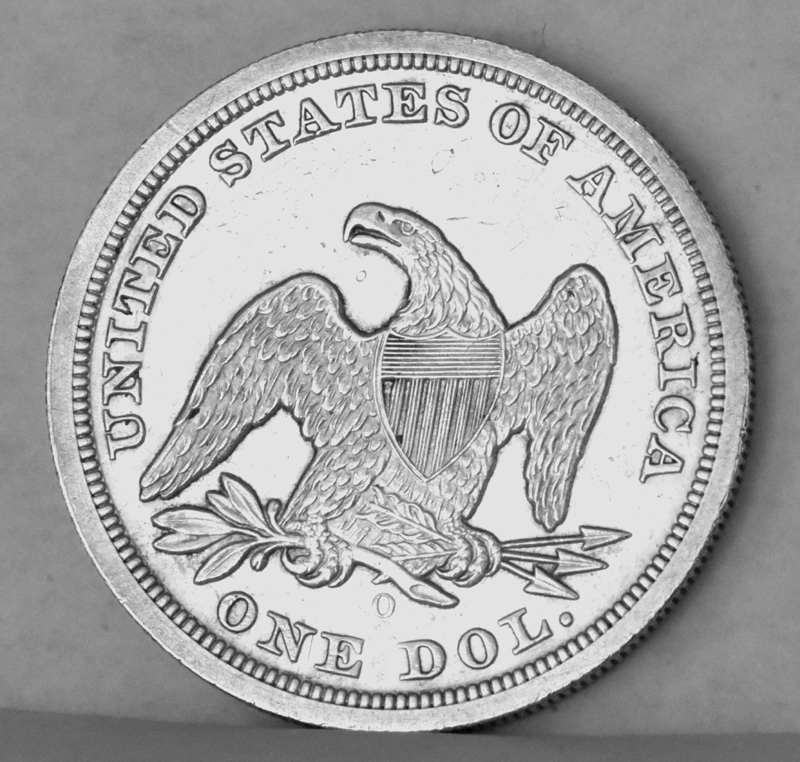 |
| This coin is slabbed and certified by NGS as uncirculated but was cleaned and thus is not worth its Red Book value. I got it for $2,300 and without the cleaning which made small scratches on the surface, the coin would be worth $6000.. The coin is stored in the D case. | This is the reverse of the coin at left. Only 59,000 of these were minted in New Orleans that year. It is certain that very few of those are still in existence that are actually uncirculated. I was lucky to be able to get one with a huge discount. | |
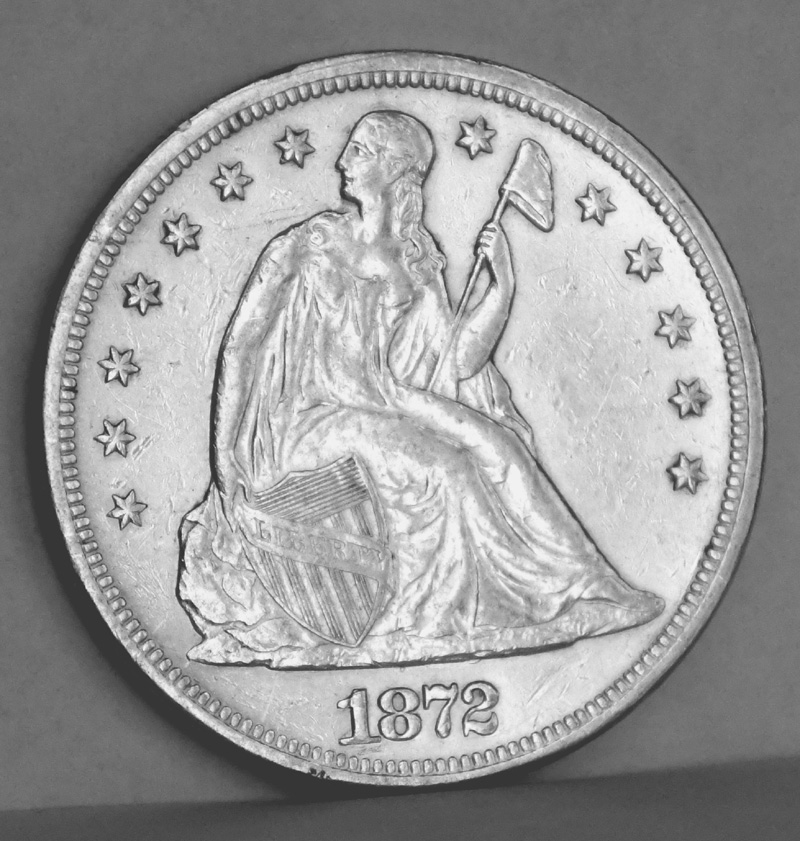 |
Although the liberty seated silver dollar was minted by three different mints, including Philadelphia, Carson City, and New Orleans, during its lifetime in U.S. commerce, the usage of the coin by ordinary citizens was not widely acceptable for various reasons and therefor, the number of these coins minted was quite limited. Only two years, 1871 and 1872, saw the numbers rise above one million, and in Carson City, the numbers were so small that each of those examples is now very expensive, even in very worn condition. It was not until 1878 with the advent of the Morgan dollar that the use of silver for dollar coins became a huge success and the mintage of these coins soared into very high numbers. | 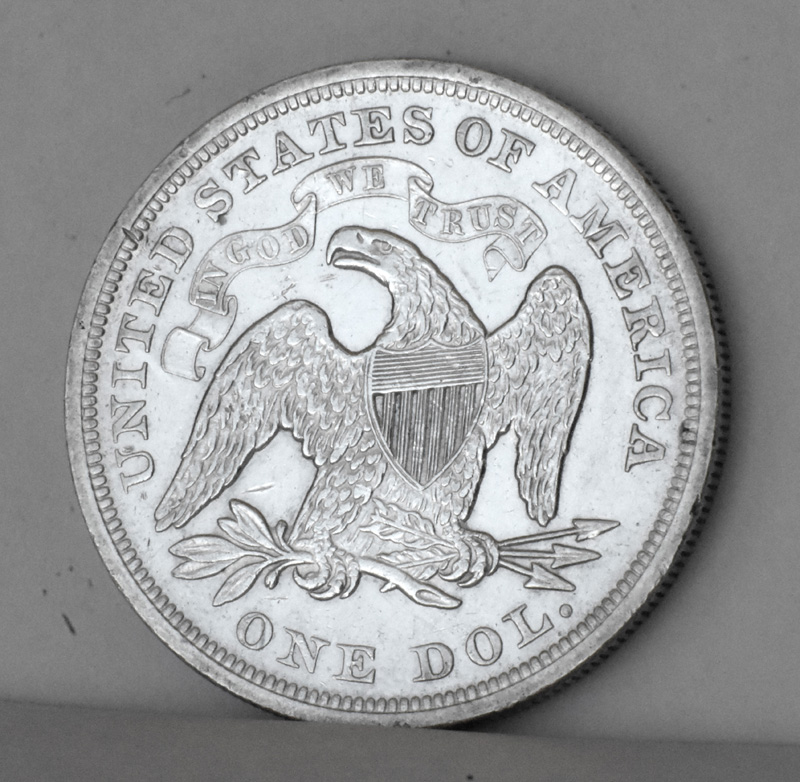 |
| 1,105,500 of these were minted in 1872 but not very many survive today in this grade. And only 296,000 were made the following year at all three mints because of the 1873 Coinage Act which halted the production of silver dollars until 1878. This coin was graded as UNC when sold to me. This coin is stored in the Miscellaneous album of halves and dollar coins. | This is the reverse of the coin at left, showing the motto above the eagle. 1872 was a very important year in the economy of the United States because several things happened that led to the great panic of 1873 and the 5 year depression that followed. For more information on those events, look at the notes that accompany the Trade Dollar coins in this web site. | |
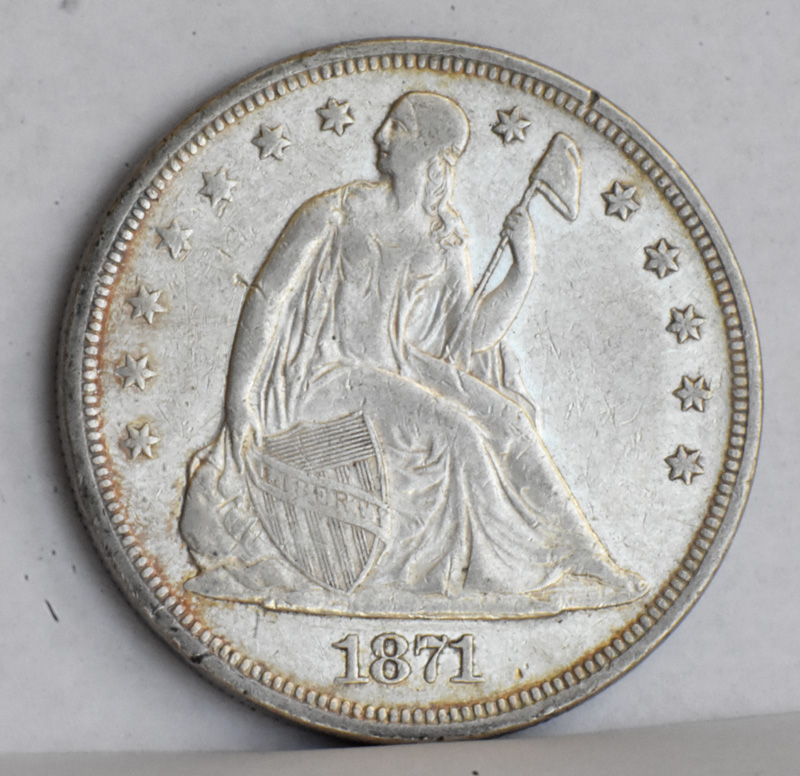 |
No silver dollar coins were minted for circulation among the public during the years from 1804 to 1836. When the government again felt the need for them in that year, the mint began the process of designing a new coin for this purpose. A design was proposed by an assistant engraver, Christian Gobrecht, in that year and though controversial, which required a number of modifications, the design was used to mint a small number of those coins in December of 1836. But the design was changed again almost immediately, including minor modifications to the obverse, but a major change on the reverse which included replacing a flying eagle with one seated on an olive branch. | 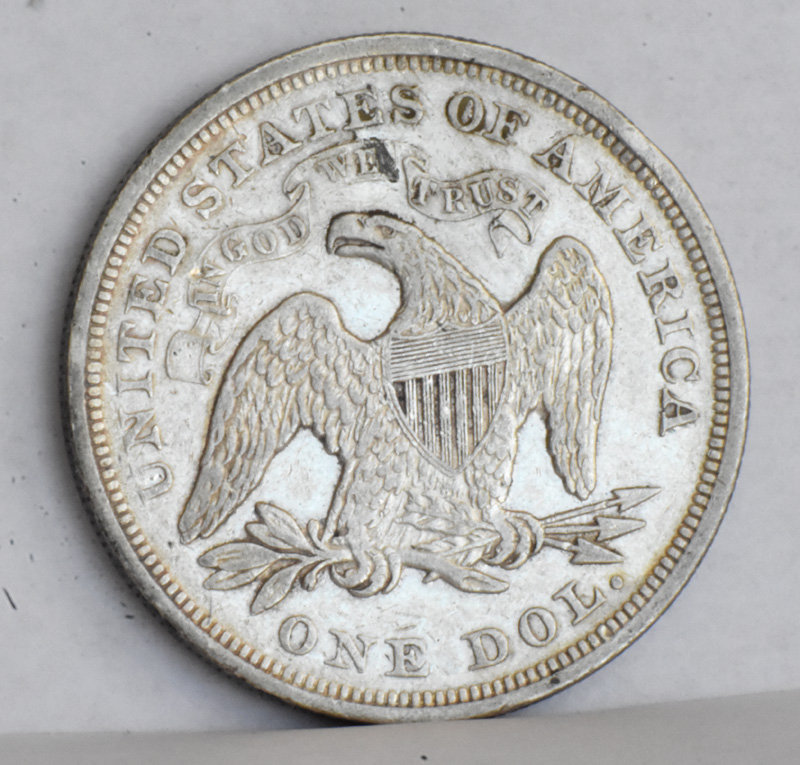 |
| This coin was graded XF by the seller but I have graded it VF 20, which makes it worth about $500 or a bit less on the PCGS web site. I bought it for $427 and hoped it would be a bargain but that may have been somewhat optimistic. This coin is stored in the Miscellaneous album, along with the one above. | This is the reverse of the 1871 coin and I must add that this year was a very bad one for Chicago because the great fire there that year killed about 300 people, destroyed 17,500 buildings, left 100,000 homeless, and burned more than 3 square miles of the city to the ground. The cause was never determined but popular songs say that Mrs. O'Leary put a lantern in the barn and a cow kicked it over. | |
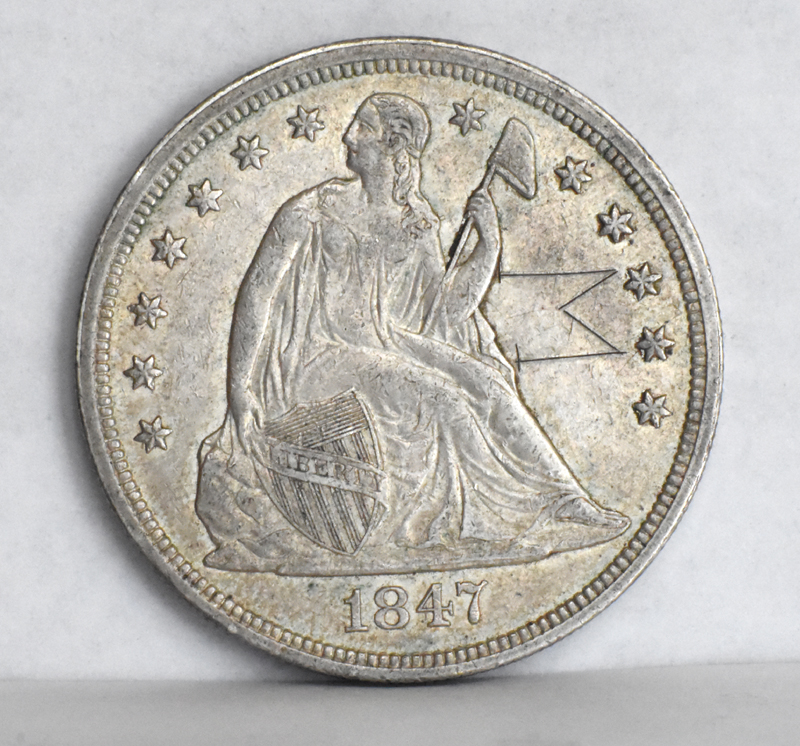 |
The Gobrecht dollar coins are all extremely rare and extremely valuable. But it is interesting to note that the reverse of these coins was designed with a flying eagle and that design was used again on obverse of the first small one cent coins in 1856. But it was so unpopular at that time that those one cent coins only survived for 3 years, after which the very popular Indian Head cent design appeared. | 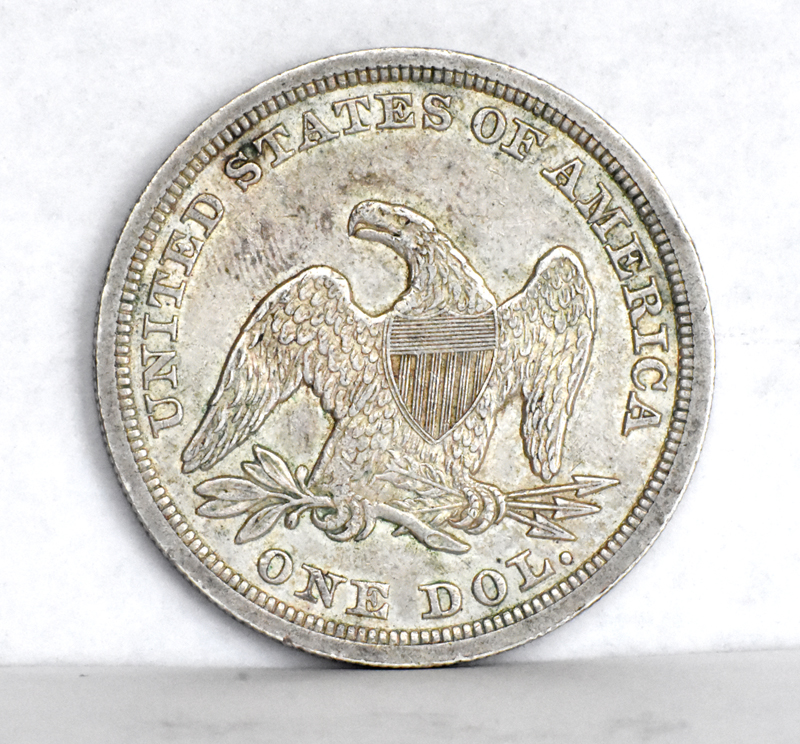 |
| Today, I have an example of both types of the Seated Liberty listed above in the U.S. Types album; the 1847 with no motto on the back shown here cost $250 and is worth about $300 today and the 1871 with the motto cost $125 and is worth about $250 today. The coin above was sold to me as having the grade of AU which would put its value at $850 if not damaged in some way but as you can plainly see, it suffers from graffiti and this added greatly to my discount. Also, the coin does not appear to qualify for that grade anyway; I think an EF 40 is more realistic, making its value about $300. Only 140,750 of these were minted and few coins survive in the higher grades. | This is the reverse of the coin at left. I am sorely tempted to clean the coin because it would look so much nicer but the industry standard says "don't clean a valuable coin". But at least this one shows the reverse without the motto. I was lucky to be able to acquire one of these examples in this grade because of the low mintage numbers. |
Problems also had arisen in the mint during the December 1836 production which resulted in at least four different versions of that coin. It wasn't until 1840 that the design and production of the silver dollar was sufficiently perfected to allow a larger number of coins to be made, although only 61,000 were minted in that year. Nearly three times that number were made the following year of 1841. I should also mention that during the years 1836 to 1839 the seated liberty dollar coin was minted with the flying eagle on the reverse and these coins are officially called Gobrecht dollars, although it is true that they are sometimes called Seated Liberty dollars by some folks. I am sure that you have noticed my notes above that refer to these coins as 'Seated Liberty' dollars, although as I have just stated, the proper designation of them is to be called 'Gobrecht' dollars. The confusion results primarily because of the design changes that occurred during those first years that the silver dollar was again being considered for large scale (that designation is proportional to the time) production and because of the problems that were had by the mint during those years. In numismatic circles, the coins dated before 1840 are always called Gobrecht dollars and are indeed very rare and very expensive, although it may be possible for a collector with sufficient funds to purchase one. Gobrecht's design of the seated liberty was a good one and although his reverse design of the flying eagle was not, that obverse design survived and was used for much of the 19th century on the silver dime, the silver quarter, and the silver half dollar. |
| 1847: January 4: Samuel Colt sells his first revolver pistol, the Colt Walker, to the U.S government for the Texas Rangers. February 5: A rescue effort, called the First Relief, leaves Johnson's Ranch to save the ill-fated Donner Party. These California bound emigrants became snowbound in the Sierra Nevada in the winter of 1846–1847, and some had resorted to cannibalism to survive. February 11: Thomas Edison, American inventor and businessman is born. February 22: The Battle of Buena Vista: 5,000 American troops under General Zachary Taylor use their superiority in artillery to drive off 15,000 Mexican troops under Antonio López de Santa Anna, defeating the Mexicans the next day. March 29: United States forces led by General Winfield Scott take Veracruz after a siege. July 1: The United States issues its first postage stamps, featuring George Washington and Benjamin Franklin. July 24: After 17 months of travel, Brigham Young leads 148 Mormon pioneers into Salt Lake Valley, resulting in the establishment of Salt Lake City. August 20: US troops defeat Mexican troops in Valencia, Mexico. September 5: Jesse James, American outlaw, guerrilla, gang leader, bank robber, train robber, and murderer from Missouri is born. |
| 1871: March 22: In North Carolina, William Holden becomes the first governor of a U.S. state to be removed from office by impeachment. April 20: U.S President Ulysses S. Grant signs the Ku Klux Klan Act, an Act of the United States Congress which empowered the President to suspend the writ of habeas corpus to combat the Ku Klux Klan (KKK) and other white supremacy organizations. May 4: The first supposedly Major League Baseball game is played. May 8: The first Major League Baseball home run is hit by Ezra Sutton of the Cleveland Forest Citys. July 21-August 26: The first ever photographs of Yellowstone National Park region are taken by the photographer William Henry Jackson during Hayden Geological Survey of 1871. July 30: An explosion on the Staten Island Ferry kills 72 and injures 135. September: 1,219 people abandon 33 whaling ships caught in the ice pack off the northern coast of Alaska. October 8: Four major fires break out on the shores of Lake Michigan in Chicago, Illinois, Peshtigo, Wisconsin, Holland, Michigan, and Manistee, Michigan. The Great Chicago Fire is the most famous of these, leaving nearly 100,000 people homeless, but the Peshtigo Fire killed as many as 2,500 people, making it the deadliest fire in U.S. history. October 24: 18 Chinese immigrants in Chinatown, Los Angeles, are killed by a mob of 500 men. October 27: Boss Tweed of Tammany Hall is arrested for bribery, ending his grip on New York City. November 17: The National Rifle Association is granted a charter by the state of New York. |
| 1872: January 2: Brigham Young is arrested for bigamy. March 1: Yellowstone National Park is established as the world's first national park. March 26: The 7.4–7.9 Mw Lone Pine earthquake shakes eastern California. Twenty-seven people are killed and fifty-six injured. May 10: Victoria Woodhull becomes the first woman nominated for President of the United States. May 22: President Ulysses S. Grant signs the Amnesty Act of 1872 into law restoring full civil rights to all but about 500 Confederate sympathizers. June 4: Two men lead investors to land near the Wyoming-Colorado border claiming to have found diamonds there, starting a diamond craze in the western US, which is later revealed as a fraud. August: Aaron Montgomery Ward issues the first Montgomery Ward mail order catalogue from Chicago. November 5: In defiance of the law, suffragist Susan B. Anthony votes for the first time. On November 18 she is served an arrest warrant and in the subsequent trial is fined $100, which she never pays. November 7: The USS Mary Celeste sets sail from New York, bound for Genoa. On December 4 the ship is found by the Canadian brigantine Dei Gratia in the Atlantic ocean, in a disheveled but seaworthy condition under partial sail and with her lifeboat missing. The last entry in her log was dated 10 days earlier. She was still amply provisioned when found and her cargo of denatured alcohol was intact. The captain’s and crew’s personal belongings were undisturbed but none of those who had been on board were ever seen or heard from again. November 9: In Boston, Massachusetts, a large fire begins to burn on Lincoln Street. The two-day event destroys about 65 acres of the city, including 776 buildings, much of the financial district, and causes $60 million in damage. |